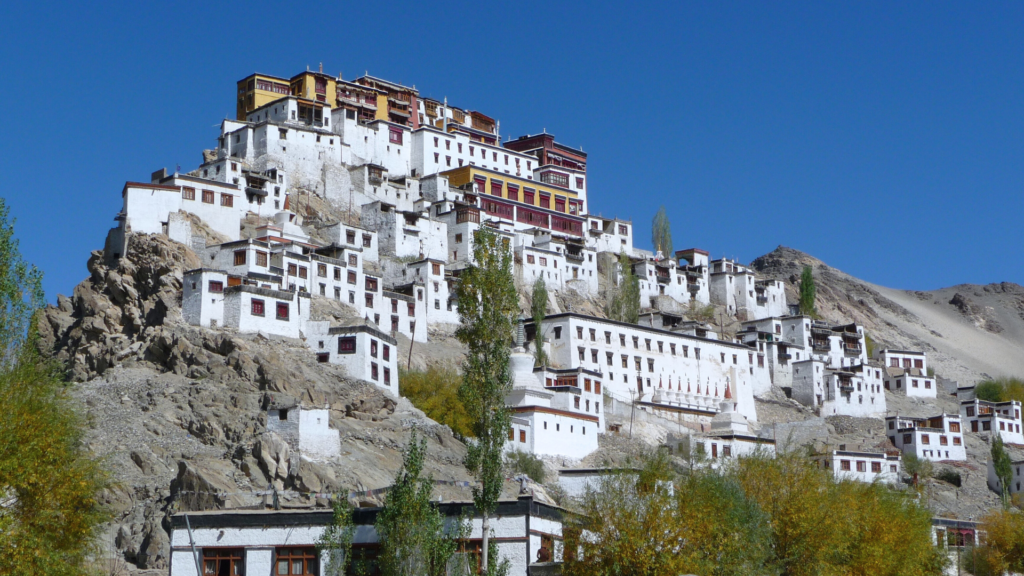

Revealing the Himalayan Mystical Land Leh Ladakh in the far north of India is a region that appears to be almost extraterrestrial, sitting high within the Himalayas. Renowned for its harsh ruggedness, wide stretches of desert, Buddhist monasteries, and stunning mountain ranges, Leh Ladakh has been beckoning travelers and adventurers from around the world. If adventure, spirituality, or a serene getaway is what you seek, Leh Ladakh offers an experience so profound that it becomes imprinted on your mind forever.
In this blog, we’ll take you around the magical paradise of Leh Ladakh. Right from exploring its unspoiled landscapes and action-packed activities to learning about its cultural heritage and scenic spots, this guide will help you to make the most of your Leh Ladakh trip.
Why Travel to Leh Ladakh?
Leh Ladakh is not just a travel destination; it’s an experience that will provide you with a new perception of life. Here’s why you must travel to this mystical land:
Breathtaking Landscapes: Leh Ladakh is surreal in its beauty. Endless barren deserts, snow-clad mountains that touch the sky, crystal lakes, and valleys filled with monasteries make it a photographer’s paradise. The changing hues of the sky during sunrise and sunset enhance the region’s charm.
Adventure Haven: For adventure lovers, Leh Ladakh offers sports such as trekking, bike riding, river rafting, and off-road driving. Its barren terrain and mountain passes at high altitudes offer the adventure lovers a mecca.
Spiritual Retreat: Leh Ladakh offers old Buddhist monasteries and temples with a serene atmosphere for spiritual retreat. Leh Ladakh has a deeply rooted Buddhist culture that provides a chance to witness rituals, celebrations, and religious practices.
Cultural Immersion: Ladakhis are known for their generosity, and traveling to Leh Ladakh gives you a chance to interact with them and see how they live their rich culture, traditions, and way of life.
Isolation and Serenity: Leh Ladakh offers a sense of serenity that is hard to find in other places on earth. The serene atmosphere, virgin terrain, and silence in the higher altitudes provide the space for contemplation and calm mind.
Best Time to Visit Leh Ladakh

Leh Ladakh is a year-round destination, but the best time to visit Leh Ladakh varies based on the kind of experience you are looking for:
- Summer (May to September): Leh Ladakh is the best place to go in summer, with fine weather, blue sky, and between 15° to 30° degrees in temperature. You can travel at will during these months. Each and every road remains usually open throughout these seasons, and places like Pangong Lake, Nubra Valley, and Khardung La Pass become no more than just a casual visiting option for you.
- Winter (October to March): Although temperature drops drastically during winter, dropping to -30°C, the region is a white winter wonderland, with snow-capped mountains and frozen lakes. Winter is ideal for those seeking a more serene and isolated experience, though movement is difficult with roadblocks.
- Monsoon (July to September): The defining feature of monsoon in this area is heavy rains, and some roads become inaccessible due to landslides. If you plan to go to Leh Ladakh during monsoon season, ensure that you check road conditions and weather updates before finalizing your tour.
Top Attractions in Leh Ladakh
Leh Ladakh abounds with stunning natural landscapes, cultural symbols, and historical sites. Following are some of the must-see places when you organize a Leh Ladakh trip:
- Pangong Lake
One of the most famous lakes in the world, Pangong Lake is a picturesque body of water that lies across the Indo-China border. The lake is well-known for its stunning blue color, with bare hills running along it on all sides. Pangong Lake is also famous for its colors changing to various blues, especially at dawn and dusk. A visit to Pangong Lake is one of the wonders of any Leh Ladakh trip.
Best Time to Visit: May to September.
- Nubra Valley
Nubra Valley lies in the northern part of Leh Ladakh and is a stunning high-altitude desert known for its sand dunes, Buddhist monasteries, and double-humped Bactrian camels, which are very rare. The valley is home to some of the most scenic landscapes of the region, with snow-capped mountains, rivers, and green spots amidst the desert landscape.
Chief Attractions: Diskit Monastery, Hunder Sand Dunes, and Sumur Monastery.
- Leh Palace
Built in the 17th century, the Leh Palace is a representative structure that features panoramic views of Leh and the surrounding valleys. It is quite similar to the Potala Palace located in Lhasa, Tibet, and represents the rich culture of the place. The palace features a museum that holds the artifacts of Ladakhi culture, thus it is a perfect place for those who love history.
Optimal Time to Visit: Summer season (May to September).
- Khardung La Pass
Khardung La stands at 18,379 feet, making it one of the world’s highest motorable passes. The pass offers breathtaking views of the surrounding snow-capped peaks and is a popular haunt for adventure lovers, especially bikers. Reaching Khardung La is an achievement for most tourists, and it’s a great photography spot.
Best Time to Visit: May to September.
- Magnetic Hill
The Magnetic Hill is a natural phenomenon where vehicles appear to move uphill on their own when parked in neutral. It’s one of the attractions on the Leh Ladakh tour circuit, attracting inquisitive visitors. The spot offers a view of the open plains and distant mountains, so it’s a suitable location for sightseeing.
Best Time to Visit: Summer season (May to September).
- Thiksey Monastery
Located on a hilltop, Thiksey Monastery is one of the largest and most beautiful monasteries in Leh Ladakh. It is an architectural marvel reminiscent of the Potala Palace of Tibet. The monastery features a massive statue of Maitreya Buddha and provides panoramic views of the valley.
Best Time to Visit: May to September.
Adventure Activities in Leh Ladakh
Leh Ladakh is a heaven for adventure seekers, with lots of activities to push your adrenaline level. Check out some of the best adventure activities to engage in:
- Trekking
Leh Ladakh features some of India’s most spectacular trekking trails with routes offering breathtaking views of the Himalayas and deep valley lines. A few of the best treks include:
Markha Valley Trek: Moderate to challenging trekking from remote villages, monasteries, and high-altitude landscapes.
Chadar Trek: A rare winter trek on the frozen Zanskar River, with a unique experience for avid trekkers.
- Cycling and Biking
Leh Ladakh is also among the favorite destinations for cycling and biking, with high-altitude passes, difficult roads, and scenic views. The Manali-Leh Highway and Srinagar-Leh Highway are popular motorbike tour routes, with plenty of scenery stops along the routes. - River Rafting
The Zanskar River is among the most suitable locations for river rafting, especially during the summer. The fast-moving river water and scenic landscape along the river are perfect for an adventure for people who love to take risks. - Wildlife Safari
Leh Ladakh is also home to different species of wildlife, including the snow leopard, Tibetan antelope, yak, and Ladakhi wild ass. Hemis National Park and Nubra Valley are perfect places for wildlife tourists to visit the fauna of the area.
Cultural Experiences in Leh Ladakh

Apart from its natural beauty and adventure sports, Leh Ladakh offers a rich cultural experience. Here are some ways to experience the culture of the destination:
- Visit Buddhist Monasteries
Leh Ladakh is renowned for its Buddhist monasteries, which are places of spirituality, meditation, and art. Apart from Thiksey Monastery, some other well-known monasteries include Hemis Monastery, Lamayuru Monastery, and Alchi Monastery. - Experience the Ladakh Festival
Structured annually in Leh, the Ladakh Festival is a vibrant celebration of Ladakhi culture, comprising traditional sports, dance, and music. It’s a great opportunity to learn about the folk customs, art, and traditions of the place. - Taste Ladakhi Cuisine
Ladakhi food is a unique blend of Tibetan, Indian, and Central Asian foods. Don’t miss trying local dishes like Thukpa (noodle soup), Momos (dumplings), Skyu (a rich stew), and Chhang (a local barley beer). These dishes are a great way of connecting with the local culture and traditions.
How to Reach Leh Ladakh
It takes an experience in itself to reach Leh Ladakh, due to its offbeat location. Following is how you can travel to Leh:
By Air: It is the easiest mode of transportation to travel to Leh. Leh Kushok Bakula Rimpochee Airport is well connected with big cities like Delhi, Srinagar, and Chandigarh.
By Road: If you are adventurous in nature, you can travel to Leh by road via the Manali-Leh Highway or Srinagar-Leh Highway. Both are lovely but difficult to access because of high altitudes and road conditions.
By Train: Leh lacks direct train connectivity, but there is a train to Jammu or Srinagar, from which you can travel to Leh by road.
Best Tips for Leh Ladakh Tour
Acclimatize Properly: Leh Ladakh is at high altitude, and altitude sickness is prevalent. Take a few days acclimatizing in Leh prior to any activity.
Pack Warm Clothes: Even during summer, temperatures can get quite low, particularly in the evenings. Always carry warm clothes.
Stay Hydrated: The dry air and high altitude can contribute to dehydration. Drink lots of water to keep yourself hydrated.
Respect Local Culture: Leh Ladakh is a culturally diverse area with strong Buddhist traditions. Be respectful of the local customs, particularly when visiting monasteries and temples.
Conclusion: Leh Ladakh – A Journey to the Top of the World
Leh Ladakh is a destination where adventure and spirituality blend, where nature’s raw beauty entwines with cultural heritage. Whether you’re looking for the thrill of adventure, a journey of self-discovery, or simply want to escape the hustle and bustle of everyday life, Leh Ladakh offers an experience that is as rewarding as it is awe-inspiring. So, pack your bags, brace yourself for the high-altitude journey, and embark on an unforgettable adventure to the Top of the World.







Leave a comment: